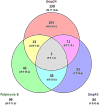Scorpion Venom Antimicrobial Peptides Induce Siderophore Biosynthesis and Oxidative Stress Responses in Escherichia coli
- PMID: 33980680
- PMCID: PMC8125054
- DOI: 10.1128/mSphere.00267-21
Scorpion Venom Antimicrobial Peptides Induce Siderophore Biosynthesis and Oxidative Stress Responses in Escherichia coli
Abstract
The increasing development of microbial resistance to classical antimicrobial agents has led to the search for novel antimicrobials. Antimicrobial peptides (AMPs) derived from scorpion and snake venoms offer an attractive source for the development of novel therapeutics. Smp24 (24 amino acids [aa]) and Smp43 (43 aa) are broad-spectrum AMPs that have been identified from the venom gland of the Egyptian scorpion Scorpio mauruspalmatus and subsequently characterized. Using a DNA microarray approach, we examined the transcriptomic responses of Escherichia coli to subinhibitory concentrations of Smp24 and Smp43 peptides following 5 h of incubation. Seventy-two genes were downregulated by Smp24, and 79 genes were downregulated by Smp43. Of these genes, 14 genes were downregulated in common and were associated with bacterial respiration. Fifty-two genes were specifically upregulated by Smp24. These genes were predominantly related to cation transport, particularly iron transport. Three diverse genes were independently upregulated by Smp43. Strains with knockouts of differentially regulated genes were screened to assess the effect on susceptibility to Smp peptides. Ten mutants in the knockout library had increased levels of resistance to Smp24. These genes were predominantly associated with cation transport and binding. Two mutants increased resistance to Smp43. There was no cross-resistance in mutants resistant to Smp24 or Smp43. Five mutants showed increased susceptibility to Smp24, and seven mutants showed increased susceptibility to Smp43. Of these mutants, formate dehydrogenase knockout (fdnG) resulted in increased susceptibility to both peptides. While the electrostatic association between pore-forming AMPs and bacterial membranes followed by integration of the peptide into the membrane is the initial starting point, it is clear that there are numerous subsequent additional intracellular mechanisms that contribute to their overall antimicrobial effect.IMPORTANCE The development of life-threatening resistance of pathogenic bacteria to the antibiotics typically in use in hospitals and the community today has led to an urgent need to discover novel antimicrobial agents with different mechanisms of action. As an ancient host defense mechanism of the innate immune system, antimicrobial peptides (AMPs) are attractive candidates to fill that role. Scorpion venoms have proven to be a rich source of AMPs. Smp24 and Smp43 are new AMPs that have been identified from the venom gland of the Egyptian scorpion Scorpio maurus palmatus, and these peptides can kill a wide range of bacterial pathogens. By better understanding how these AMPs affect bacterial cells, we can modify their structure to make better drugs in the future.
Keywords: AMPs; E. coli; Escherichia coli; RT-PCR; antimicrobial peptides; microarray analysis; microarrays; oxidative stress; scorpion venom.
Copyright © 2021 Tawfik et al.
Figures


Similar articles
-
Improving the Therapeutic Index of Smp24, a Venom-Derived Antimicrobial Peptide: Increased Activity against Gram-Negative Bacteria.Int J Mol Sci. 2022 Jul 20;23(14):7979. doi: 10.3390/ijms23147979. Int J Mol Sci. 2022. PMID: 35887325 Free PMC article.
-
Characterisation of three alpha-helical antimicrobial peptides from the venom of Scorpio maurus palmatus.Toxicon. 2016 Jul;117:30-6. doi: 10.1016/j.toxicon.2016.03.014. Epub 2016 Mar 24. Toxicon. 2016. PMID: 27019370
-
An Smp43-Derived Short-Chain α-Helical Peptide Displays a Unique Sequence and Possesses Antimicrobial Activity against Both Gram-Positive and Gram-Negative Bacteria.Toxins (Basel). 2021 May 11;13(5):343. doi: 10.3390/toxins13050343. Toxins (Basel). 2021. PMID: 34064808 Free PMC article.
-
Antimicrobial peptides from scorpion venoms.Toxicon. 2014 Sep;88:115-37. doi: 10.1016/j.toxicon.2014.06.006. Epub 2014 Jun 19. Toxicon. 2014. PMID: 24951876 Free PMC article. Review.
-
Animal Venom Peptides: Potential for New Antimicrobial Agents.Curr Top Med Chem. 2017;17(10):1119-1156. doi: 10.2174/1568026616666160930151242. Curr Top Med Chem. 2017. PMID: 27697042 Review.
Cited by
-
Antimicrobial Peptide Analogs From Scorpions: Modifications and Structure-Activity.Front Mol Biosci. 2022 May 26;9:887763. doi: 10.3389/fmolb.2022.887763. eCollection 2022. Front Mol Biosci. 2022. PMID: 35712354 Free PMC article. Review.
-
Antimicrobial Potential of Scorpion-Venom-Derived Peptides.Molecules. 2024 Oct 27;29(21):5080. doi: 10.3390/molecules29215080. Molecules. 2024. PMID: 39519721 Free PMC article. Review.
-
Antimicrobial Activity of Apis mellifera Bee Venom Collected in Northern Peru.Antibiotics (Basel). 2023 Apr 19;12(4):779. doi: 10.3390/antibiotics12040779. Antibiotics (Basel). 2023. PMID: 37107142 Free PMC article.
References
Publication types
MeSH terms
Substances
LinkOut - more resources
Full Text Sources
Other Literature Sources
Research Materials

